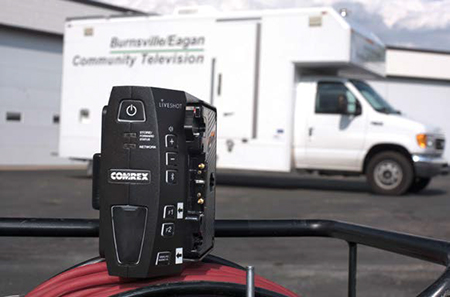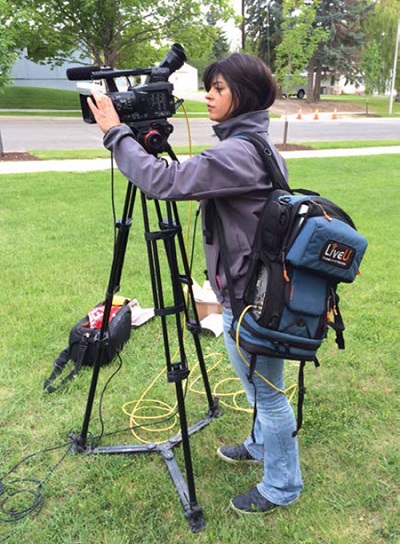Broadcasters Laud Bonded-Cell Advantages

Burnsville Community TV in Burnsville, Minn., connects a Comrex bonded-cell unit to its mobile production truck to cover local events.
OTTAWA, ONTARIO—With its ability to connect ENG crews with their stations via low-cost cellular, Ethernet, or Wi-Fi networks, bonded-cell transmission technology has made live news remotes more accessible and affordable for TV broadcasters. But every technology has its limits, and bonded-cell is no exception.
That said, broadcasters who use bonded-cell backpacks (and now smaller portable transmitters) love it so much that they are happy to adopt workarounds that cope with these limits, while keeping bonded-cell at the forefront of their ENG efforts.
“Bonded-cell technology has allowed us to economically expand our Montana stations’ coverage to encompass the entire state, rather than being limited to a few larger urban areas,” said Neal Boling, station manager of Spokane, Wash.-based NBC affiliate KHQ-TV. “Thanks to our LiveU bonded-cell transmitters, our ‘Wake Up Montana’ morning show has live content from all of them every day.”
The biggest appeal of bonded-cell technology is the low-cost reach it provides to ENG crews. “With our Comrex units, which connect via 4G to Verizon, we can do live news shoots all over San Francisco,” said Arnie Loleng, operations manager for Ohlone TV, a closed circuit/streaming TV channel operated by Fremont, Calif.-based Ohlone College’s broadcasting faculty. “As a community college on a budget, we can’t afford to use microwave or satellite trucks to train our students on ENG work. Bonded-cell lets us provide students with this invaluable training.”
KTUU-TV, the NBC affiliate in Anchorage, Alaska, uses a mix of Comrex, Dejero, and LiveU bonded-cell technology. “Since cellular coverage is largely limited to urban areas, we use bonded-cell connected via Ethernet or Wi-Fi to send back live shots from remote communities,” said Scotty Smith, KTUU’s production manager. “This allows us to do a far better job of covering Alaska live than we were able to do before.”
Burnsville Community TV in Burnsville, Minn., connects a Comrex bonded-cell unit to its mobile production truck. “We shoot a lot of high school football games,” said Jay Golden, television production specialist for BCTV. “The Comrex allows us to send a switched live feed to our headend as a backup to our local cable TV system. It is effective, low-cost redundancy.”
Get the TV Tech Newsletter
The professional video industry's #1 source for news, trends and product and tech information. Sign up below.
Bonded-cell’s second big advantage is its ease of use. Compared to the complexities of connecting microwave and satellite trucks, “bonded-cell is pretty much plug-and-play, even when you are doing long-distance live shots as we did using LiveU from San Francisco to our station WOIO [CBS] in Cleveland, during the 2015 NBA Finals,” said Bob Maupin, regional director of technology for Raycom Media. “Our people were pretty much able to shoot and broadcast anywhere within the arena”
A third advantage: The low-cost of bonded-cell transmission, compared to other more expensive options, allows up-and-coming stations to go head-to-head with deeper-pocketed competitors. A case in point: South Florida’s América TeVé relies on its Aviwest bonded-cell transmitters to help produce eight hours of live news daily. “When it comes to covering local news, Aviwest lets us take on the big networks and be on the same page,” said Gerd Rieger, senior engineering manager for the Miami-based independent Spanish language TV station.
COPING WITH LIMITS

KHQ-TV uses LiveU bonded-cell transmitters for live remotes on its “Wake Up Montana” morning show.
Because it is reliant on whatever network it has been tailored to—be it cellular, Ethernet, or Wi-Fi—bonded-cell technology is only as good as the network(s) it has access to.
In San Francisco, Ohlone College’s Comrex units are only equipped with Verizon 4G cellular cards. “If we can’t connect via Verizon and there isn’t a Wi-Fi/Ethernet connection accessible, then we can’t connect at all,” said Arnie Loleng. “This can limit us if we are on the edge of Verizon’s coverage, outside of the urban area.”
Even when coverage is sufficient, bonded-cell transmitters can have problems in areas where cellular networks are overloaded with traffic. “We were covering a high school graduation where there about 3,000 people; many live-tweeting the event,” said BCTV’s Jay Golden. “This led to a number of dropouts over cellular.”
This traffic issue, plus the limits of cellular networks, has motivated KDFW-TV to add an ING (Internet newsgathering) vehicle, when needed, to its TVU networks mobile uplink backpacks. “The ING vehicle, with its ability to send traffic via burstable satellite IP, helps us fill in the gaps in cellular and congested networks,” said Jim Ocon, vice president of engineering for the Dallas/Ft. Worth Fox affiliate. “Combined, both give us tremendous remote coverage.”
América TeVé’s Aviwest bonded-cell unit can access a range of cellular networks using their SIM cards. This means that the channel can bypass the major cellular carriers when their networks become congested. “When the returns were coming in during the 2012 presidential and congressional elections, our crews at the campaign offices were able to get out while other crews reliant on just one or two carriers couldn’t,” said Rieger.
Signal latency (delays) can be an issue when the bonded-cell connections aren’t that strong. “We can experience latency issues when we are accessing either 4G or Wi-Fi that has low signal issue,” said Loleng. “This can be a problem if you are trying to do a two-way conversation between the anchor and the reporter on scene.”
Even with the limits noted above, bonded-cell technology is endorsed by all of the people that TV Technology interviewed for this article.
“It has just changed and enhanced the way we do live remotes,” said Maupin. “Bonded-cell doesn’t fit every application, but it fits the majority of them at a lower price and with much simpler technical requirements than microwave or satellite.”
“The biggest advantage of bonded-cell is that you can get your people to many more locations than you could with the transmission alternatives, simply because you can afford to buy and deploy more units,” said Ocon. “The tradeoff, of course, is that you are sharing your bandwidth with other cellular users.”
“Bonded-cell technology allows us to cover much more news than ever before,” concluded Smith. “At the same time, it does so at a price that fits our budget.”
James Careless is an award-winning journalist who has written for TV Technology since the 1990s. He has covered HDTV from the days of the six competing HDTV formats that led to the 1993 Grand Alliance, and onwards through ATSC 3.0 and OTT. He also writes for Radio World, along with other publications in aerospace, defense, public safety, streaming media, plus the amusement park industry for something different.

